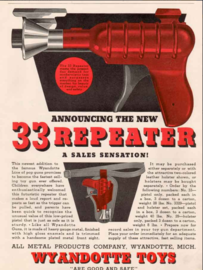Cap Guns
Collectible Type
A cap gun, cap pistol, or cap rifle is a toy gun that creates a loud sound simulating a gunshot and a puff of smoke when a small percussion cap is exploded. Cap guns were originally made of cast iron, but after World War II were made of zinc alloy, and most newer models are made of plastic.
Cap guns get their name from the small discs of shock-sensitive explosive compounds (roughly 0.055 to 0.065 inches in diameter) that provide the noise and smoke, effectively the same as the separate percussion cap primers used in real firearms of the mid to late 1800s, although invariably smaller and made from cheap plastic or paper rather than soft metal. Some are arranged in plastic rings of eight or twelve. There are also single caps, roll caps (of 50 to 500), and disk caps, all of which are actually extremely small versions of percussion fireworks. Armstrong's mixture is often used today as the explosive, but previously the tiny powder charge was a simple mixture of potassium perchlorate, sulfur, and antimony sulfide sandwiched between two paper layers which hold in the gases long enough to give a sound report when the cap is struck.
Subject ID: 6038
MoreA cap gun, cap pistol, or cap rifle is a toy gun that creates a loud sound simulating a gunshot and a puff of smoke when a small percussion cap is exploded. Cap guns were originally made of cast iron, but after World War II were made of zinc alloy, and most newer models are made of plastic.
Cap guns get their name from the small discs of shock-sensitive explosive compounds (roughly 0.055 to 0.065 inches in diameter) that provide the noise and smoke, effectively the same as the separate percussion cap primers used in real firearms of the mid to late 1800s, although invariably smaller and made from cheap plastic or paper rather than soft metal. Some are arranged in plastic rings of eight or twelve. There are also single caps, roll caps (of 50 to 500), and disk caps, all of which are actually extremely small versions of percussion fireworks. Armstrong's mixture is often used today as the explosive, but previously the tiny powder charge was a simple mixture of potassium perchlorate, sulfur, and antimony sulfide sandwiched between two paper layers which hold in the gases long enough to give a sound report when the cap is struck.
Subject ID: 6038
Subject ID: 6038
